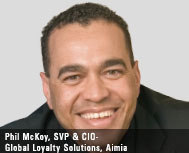
CIOTechOutlook >> Magazine >> July - 2016 issue
Importance of Partnership among CMOs and CIOs
By
 Marketers have always been challenged to deliver on the perceived potential value of marketing technologies. This pressure is, if anything, increasing as technological change - and changes in consumer behavior–ratchet up this perceived potential. The most innovative and advanced brands are now well along in building competitive advantage through technology-driven marketing.
Marketers have always been challenged to deliver on the perceived potential value of marketing technologies. This pressure is, if anything, increasing as technological change - and changes in consumer behavior–ratchet up this perceived potential. The most innovative and advanced brands are now well along in building competitive advantage through technology-driven marketing.At its heart, loyalty marketing has always been about creating a long-term value exchange between brands and customers–in exchange for their information, brands deliver customers a better, more personalized experience.
These simple core benefits that Form the basis of every loyalty program are:
• Shift - Acquire new customers
• Lift - Increase the spending of existing customers
• Retain - Reduce the turnover rate of customers
• Profit - Shift customer spending to higher-margin products
But what has recently unlocked loyalty outcomes for more brands in more industries are technological advancements. Cloud computing, mobile technology, and state-of-the-art loyalty platforms today give brands unprecedented power to harness customer insights and deliver personalized, relevant offers and experiences at the right time and place, through channel(s) of the customer’s own choosing. Data-driven loyalty programs, social media scoring and monitoring, advanced analytics, and robust campaign management platforms are now at a maturity level sufficient to enable brands to maintain economical one-to-one relationships with each and every one of their customers.
For CIOs and CMOs, loyalty marketing seems to be an area of common interest, common opportunity, and shared pressure to deliver. However, loyalty technology is only as useful as the collective hand that wields it. All too often, CIOs and CMOs find the challenge of effective collaboration quite difficult to manage. While both are coming around to the idea that they need to partner better, when it comes to how to execute, they don’t typically see eye-to-eye. The CMO feels speed and customer experience is critical because he or she must get to market - and obtain market outcomes - quickly. The traditional CIO must balance an organization’s need for speed and innovation with efficiency, deliverability and in particular, privacy and security. The relationship between a CMO and a CIO is thus often fraught with tension.
That said, the need for collaboration has become increasingly critical to realizing the potential of today’s marketing technology. CMOs have had to become more and more reliant on CIOs to solve for loyalty from a technical standpoint. At the same time, CMOs are getting more control in defining priorities and budgets for technology. These shifts in responsibility, coupled with the fact that most loyalty technology is now consumer-facing, makes strategizing, implementing, and maintaining loyalty initiatives important to both CMO and CIO - offering a unique opportunity for both to collaborate to accomplish the goal.
So how should it happen? In general, CMOs are best suited to own the business strategy for loyalty programs, implementation, and maintenance, while CIOs must lead in evaluating new technology trends - helping to vet and implement the critical strategies, but also helping to find the “sweet spot” between go-to-market speed and efficiency, deliverability, and especially security. From our experience, CMO and CIO collaborations of this kind position loyalty for maximum success.
It’s not always easy, but today’s loyalty opportunities offer CIOs and CMOs a unique chance to collaborate and unlock true business transformation, employing the latest technologies to establish stronger and more sustainable connections between brand and consumer. The time to start is now.
CXO Insights
Improving customer experience with a dedicated...
By Nitin Singhal, Senior Director, CX Solutions, Oracle India
Industrial Internet of Things and its Impact on...
By Venkatesh Jagannath, Head - India Research Centre, Schneider Electric
How Not To Automate Your Business




